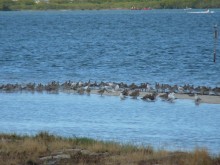It is probably fair to say that bird watching is one of the safer recreational pursuits! Nevertheless, there are still health and safety issues to consider. Because watching waders involves visits to open, often muddy habitats, suitable clothing is a must. As it can get quite hot in summer in Queensland, cool clothing providing protection against sunburn is preferred by most wader watchers. This usually means long, loose-fitting cotton pants with a long-sleeved shirt and a broad-brimmed hat. Long pants also offer some protection from Irukandji and box jellyfish, both found in coastal waters of northern Queensland, especially in the summer months.
You should choose your footwear carefully, bearing in mind that you may be walking on mudflats or even through water. Many enthusiasts wear neoprene boots, which can be bought from sport and dive shops. They give good ankle and under-foot protection, don’t get sucked off when walking in soft mud and are easily cleaned with a hose at the end of the day. Highly venomous stonefish are common in estuaries along the whole Queensland coast and footwear with a reasonably thick sole is essential.
Before setting out, there are a few essentials you should take along. Most importantly, you should always carry a bottle of water. Sunscreen and insect repellent should also be essentials on the list. A field guide, water, lunch or a snack and accessories can be carried in a backpack or lightweight vest. In some parts of northern Australia, the tidal range is very large and it is easy to become stranded if preoccupied with the wader watching. Be aware of what is happening around you!
Finally, north of the Tropic of Capricorn, estuarine crocodiles co-inhabit areas where waders are found. Take notice of all warning signs and remember to set up your scope several metres away from the water’s edge, especially when the bank is steep.

